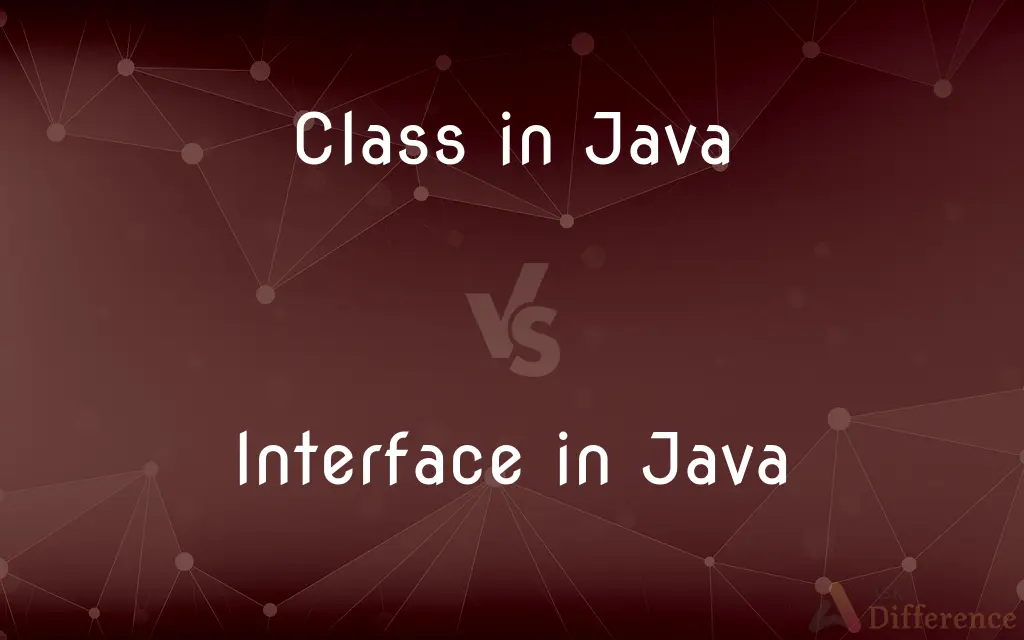Class in Java vs. Interface in Java — What's the Difference?
By Tayyaba Rehman & Urooj Arif — Published on February 5, 2024
A Java class is a blueprint for objects, defining their state and behavior, while an interface is a contract in Java, defining methods that implementing classes must use without providing their implementation.

Difference Between Class in Java and Interface in Java
Table of Contents
ADVERTISEMENT
Key Differences
In Java, a class is a fundamental construct that defines the structure and behavior of objects. It encapsulates data and methods that operate on the data. Classes are used to create objects and implement their functionalities. On the other hand, an interface in Java is a completely abstract class that is used to group related methods with empty bodies. Interfaces are used to provide a common behavior that multiple classes can implement, ensuring that they provide implementations for all the methods declared in the interface.
A class in Java is used to create concrete objects. It can contain concrete methods (methods with an implementation) and state (variables). Classes support constructors, which are special methods used to initialize new objects. Conversely, an interface is a reference type in Java that contains only constants and abstract methods - methods without a body. Interfaces cannot be instantiated on their own and must be implemented by classes or extended by other interfaces.
In Java, classes support inheritance, meaning one class can extend another class, inheriting its properties and methods. This promotes code reuse and polymorphism. However, a class can extend only one other class. In contrast, interfaces allow multiple inheritances, where a class can implement multiple interfaces, and interfaces can extend multiple other interfaces, promoting a high level of abstraction and separation of interface from implementation.
Classes in Java can have fields (variables), methods, constructors, blocks, nested classes, and interfaces. The access modifiers like private, protected, public, and default control the visibility of these members. In contrast, interfaces in Java can have constants (public static final variables) and abstract methods. From Java 8 onwards, interfaces can also have default and static methods with a body.
The concept of a class in Java revolves around encapsulation and the object-oriented paradigm, where the idea is to bundle data and methods operating on the data together. Interfaces in Java, however, are more about abstraction and decoupling, allowing for flexible system design where the implementation can vary independently from the interface.
ADVERTISEMENT
Comparison Chart
Nature
Blueprint for objects, concrete implementation
Contract for classes, abstract methods
Inheritance
Supports single inheritance (extends)
Supports multiple inheritances (implements, extends)
Members
Fields, methods, constructors, blocks, nested classes
Constants, abstract methods, (default and static methods from Java 8)
Instantiation
Can be instantiated directly
Cannot be instantiated directly
Method Implementation
Must provide implementation for methods
No method implementation, only method signatures
Compare with Definitions
Class in Java
A class in Java can have constructors for initializing new objects.
Public class Bike { Bike() { /* Constructor code */ } }
Interface in Java
Interfaces in Java can be implemented by classes, enforcing a contract.
Public class Motorcycle implements Drivable { public void drive() { /*...*/ } }
Class in Java
A class in Java is a template for creating objects, encapsulating data and methods.
Public class Vehicle { private int wheels; public void start() { /*...*/ } }
Interface in Java
Java interfaces allow multiple inheritances, a class can implement multiple interfaces.
Public class AmphibiousCar implements Drivable, Floatable { /*...*/ }
Class in Java
Java classes can implement interfaces to provide specific functionality.
Public class ElectricCar implements Rechargeable { /*...*/ }
Interface in Java
An interface in Java is a reference type, a collection of abstract methods.
Public interface Drivable { void drive(); }
Class in Java
Java classes support inheritance, allowing one class to inherit features from another.
Public class Car extends Vehicle { private String model; /*...*/ }
Interface in Java
Interfaces in Java 8 and later can have default methods with a body.
Public interface Flyable { default void fly() { System.out.println(Flying); } }
Class in Java
Classes in Java can have various access levels like public, private, and protected.
Public class Truck { private double loadCapacity; /*...*/ }
Interface in Java
Interfaces in Java can contain static methods from Java 8 onwards.
Public interface Renewable { static void renew() { /*...*/ } }
Common Curiosities
What is an interface in Java?
An interface in Java is a reference type, defining a contract with abstract methods.
Can a Java class implement multiple interfaces?
Yes, a Java class can implement multiple interfaces.
What is a class in Java?
A class in Java is a blueprint for creating objects, with methods and variables.
Can a Java interface extend another interface?
Yes, a Java interface can extend another interface.
What are default methods in interfaces?
Default methods are methods in an interface with a body, introduced in Java 8.
Can interfaces have constructors in Java?
No, interfaces cannot have constructors as they cannot be instantiated.
How do classes and interfaces differ in inheritance?
Classes support single inheritance while interfaces support multiple inheritances.
Can interfaces in Java contain fields?
Interfaces can contain only constants, not changeable fields.
Can a class in Java be abstract?
Yes, a class can be abstract, meaning it cannot be instantiated.
Are all methods in a Java interface abstract?
Prior to Java 8, yes, but now interfaces can have default and static methods.
Can a class extend multiple classes in Java?
No, a class can extend only one class but can implement multiple interfaces.
What is multiple inheritance in Java?
Multiple inheritance in Java refers to a class implementing multiple interfaces.
How does encapsulation relate to Java classes?
Encapsulation in Java classes involves bundling data and methods together and controlling access.
How do you define a method in a Java interface?
A method in an interface is defined as an abstract method without a body, unless it's a default or static method.
Are Java interfaces a way to achieve polymorphism?
Yes, interfaces provide a way to achieve polymorphism through method overriding.
Share Your Discovery

Previous Comparison
A4 Paper Size vs. Foolscap Paper Size
Next Comparison
Vidhan Sabha vs. Lok SabhaAuthor Spotlight
Written by
Tayyaba RehmanTayyaba Rehman is a distinguished writer, currently serving as a primary contributor to askdifference.com. As a researcher in semantics and etymology, Tayyaba's passion for the complexity of languages and their distinctions has found a perfect home on the platform. Tayyaba delves into the intricacies of language, distinguishing between commonly confused words and phrases, thereby providing clarity for readers worldwide.
Co-written by
Urooj ArifUrooj is a skilled content writer at Ask Difference, known for her exceptional ability to simplify complex topics into engaging and informative content. With a passion for research and a flair for clear, concise writing, she consistently delivers articles that resonate with our diverse audience.
















































